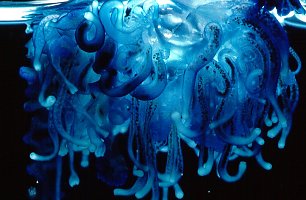|
Genus: Physalia (Bluebottle, Portuguese
man-of-war)
Life >
Eukaryotes
>
Opisthokonta >
Metazoa
(animals) > Cnidaria > Hydrozoa
> Siphonophora
Bluebottles float around in the ocean and are
notorious for their long tentacles (up to 10 m long) that sting people swimming
in the water. Each bluebottle consists of a colony of individuals that function
together as a single integrated animal.
![Bluebottle (Physalia) [Photo H. Robertson, Iziko ©]](../../images/hgr-dc05439m.jpg)
Bluebottle (Physalia) washed
up on beach [Photo H. Robertson, Iziko ©] |

Close-up of floating Bluebottle [Photo G.
Williams ©]. |
|
A bluebottle consists of a collection of individual animals
morphologically developed for specific functions: there is the individual that
develops as the floater, those that catch prey (dactylozoids), those that digest
the prey (gastrozoids) and those that undertake reproduction (gonozoids). As the
individuals making up a bluebottle are clones of each other (i.e. have identical
genes), it is debatable whether a bluebottle should be viewed as an individual
animal or as a colony of animals with highly evolved social adaptations. The
floater is capable of movement, necessary to enable it to twist and dip drying
parts of the float in the water.
The dactylozoids, otherwise termed tentacles, can extend
from 10 cm to up to 10 m long and can hence easily wrap themselves round their
prey (e.g. fish) and discharge their sting cells (nematocysts). The tentacles
then contract to bring the prey up to the gastrozoids, which fasten on to their
prey with their sucker-like mouths. The gastrozoids discharge digestive enzymes
to break down the tissue of the prey and the liquid food is then sucked in and
transmitted to other individuals via a series of internal canals. The gonozoids
focus exclusively on reproduction and utilize the food supplied by the
gastrozoids to manufacture eggs and sperm.
Bluebottles are capable of inflicting a painful sting, the
result of the discharging of a large number of stinging cells (nematocysts)
simultaneously when the tentacles make contact with your body. In the event of
being stung, treat the skin with vinegar and apply ice. Severe cases can affect
the blood flow and breathing necessitating medical treatment with antihistamines
and steroids.
The nudibranch Glaucus and the purple-shelled snail
Janthina eat bluebottles out at sea. Those that get washed up on the
beach are devoured by plough shells (Bullia species).
References
-
Branch, G. and Branch, M. 1981. The living shores of
southern Africa. C. Struik Publishers, Cape Town.
-
Branch, G.M., Griffiths, C.L., Branch, M.L. &
Beckley, L.E. 1994. Two Oceans. A guide to the marine life of southern
Africa. David Philip, Cape Town.
Text by Hamish Robertson
|
